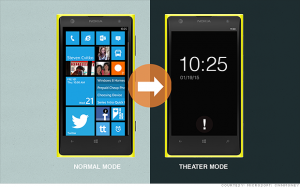Microsoft Patents New Inconspicuous (Theater) Mode Feature for Smartphones
 Microsoft has just obtained a patent for a new smartphone feature that the company is calling “”inconspicuous mode.” It is designed to make your device less noticeable, which of course is favorable in certain environments (i.e. - in a movie theater or restaurant). The patent was awarded on Thursday, and was first noticed and publicized by Patent Yogi, an India-based consulting firm.
Microsoft has just obtained a patent for a new smartphone feature that the company is calling “”inconspicuous mode.” It is designed to make your device less noticeable, which of course is favorable in certain environments (i.e. - in a movie theater or restaurant). The patent was awarded on Thursday, and was first noticed and publicized by Patent Yogi, an India-based consulting firm.
The new mode, which is also being called “theater mode” for obvious reasons, is designed around the idea that smartphones should be smart enough to not annoy the people around them in certain situations. Of course, a mode like this would not be so impressive if it weren't capable of being triggered automatically.
You've probably seen similar silent mode features on other phones before, where you're able to activate the mode manually. Microsoft's vision is for an inconspicuous mode that comes on automatically whenever your smartphone's GPS detects that it is within a movie theater, or when the facility's Bluetooth beacon instructs the phone to enter into theater mode. That point makes some of us question whether the feature will be fully optional, and exactly what phone features will be impacted when inconspicuous mode is enabled?
Inconspicuous Mode vs. Silent Mode
You might be wondering why inconspicuous mode is so much better than the conventional silent mode we all know about. First, silent mode does not address other issues like the brightness of the phone, keypad effects, and other usage factors that could cause disturbances. Furthermore, you have to manually enable silent mode, and the simple act of doing so in a dark theater is disturbing to the people around you, not to mention in an inconvenient hassle.
Inconspicuous mode will automatically enable itself, and it will do much more than make the phone quiet. According to details disclosed in the patent, the feature will use not only GPS coordinates to determine when inconspicuous mode should be enabled, it can also activate itself if the phone's light sensor detects a certain degree of darkness while the microphone detects a long silence. You could even schedule the phone to go into inconspicuous mode at a set time based on the showtime of your movie.
Obviously the implications go far beyond the movie theatre, as this will be a feature that will allow smartphones to adapt to their environments, and we could therefore see some very interesting adaptive features arise from the innovation discussed in Microsoft's recently revealed patent.
A Customizable Quiet Mode
Perhaps the most exciting part about this mode is that it can be customized to only adjust certain features. For example, you can set it to dim the lights to a specific level and change the size of the clock text to make it easier to read in low-light conditions, just in case you need to check the time during the movie but don't want to disturb everyone with the obnoxious lumens of your LCD. You can set it to only show text messages, ignore calls altogether, subtly vibrate, or perform any other function that would make the device less noticeable. Venues could then customize their beacon instructions to automatically send their patrons smarpthones into a specially tailored theater mode.
Will it Catch On?
If the patent is to be taken as a reliable indicator, it appears that this mode will have plenty of useful applications in numerous types of venues. If consumers embrace the feature, we could start seeing movie theaters set up beacons to automatically instruct phones to go into theater mode. There's a good chance that many people will see the feature as encroaching on their control over their phone if it is forcefully enabled at certain venues, but it is more likely that the general public will find the concept appealing, and it could be considered normal practice in movie theaters within the next 5-10 years.
